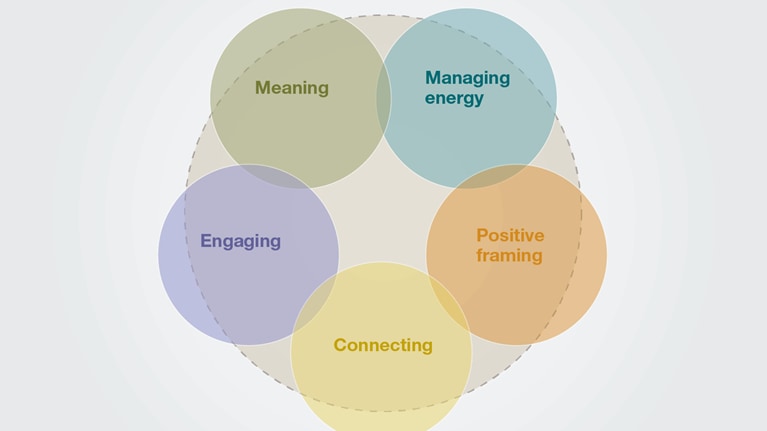One of the most common and popular conceptualizations of gender—epitomized by John Gray’s megabestselling book, Men Are from Mars, Women Are from Venus—is that men and women are essentially different species.
We believe that this depiction of gender is wrong. We’re not claiming that biological differences between the sexes don’t exist but instead are suggesting that gender differences are far more subtle than commonly believed. We propose that there is one clear difference between men and women in the United States and most of the world: the amount of power each has in society. Despite the great strides made in promoting gender equality, women and men don’t compete on a level playing field.
As a result, deeply ingrained gender stereotypes constrain the behavior and actions of women. To understand differences in how men and women behave, we must understand how men and women are expected to behave.
Power differentials
You could explain gender differences by pointing to ostensibly innate differences between males and females in competencies and skills. This is what former Harvard University president Larry Summers did, to the dismay of many, when he suggested that differences in innate ability, rather than “socialization and patterns of discrimination,” could explain why there were so few women in engineering, math, and science at the best universities. A cursory look at standardized test scores might lead you to the same conclusion, as men often outperform women in math. For example, in the United States, males have scored between 31 and 36 points higher on the math portion of the SAT in every year since 1994.
But to understand what’s going on, we need to dig deeper. This is what Luigi Guiso of the Einaudi Institute for Economics and Finance did when he and his team collected data from the 2003 Programme for International Student Assessment (PISA), which reported math test results for a quarter of a million 15-year-old students from 40 countries.1 If you look at this data set overall, you find the typical gender gap. But when Guiso looked more closely, he found that the size of the gap varied considerably across countries. And when he tried to explain where the gap was largest and smallest, he found that it was closely related to each country’s level of gender equality (measured by a political-empowerment index and an index of women in the labor market). In countries with the highest levels of gender equality, the gap in math performance disappeared. In fact, in Iceland, which has one of the highest levels of gender equality, females actually outperformed males in math. The female students had lower math scores only in societies where they lacked power. So it’s probably no surprise that work by Northwestern University’s Joan Chiao and fellow researchers have found that simply having women recall an experience in which they exercised power before they take a math test can increase their scores.2
Cultural disparities in gender equality appear outside the classroom as well. Take the world’s most popular sport, soccer. Since 2003, FIFA has ranked the women’s national soccer teams of all member countries each year by performance and quality. In research we conducted with Columbia’s Ashley Martin and INSEAD’s Pooja Mishra and Roderick Swaab, we found that gender equality predicts women’s FIFA rankings even after controlling for population size and per capita GDP. When women have more power and opportunity, a country’s female soccer team has a competitive advantage.3
So if power differentials underlie some gender differences in math and sports, we couldn’t help but wonder whether power can account for two other widely observed gender differences: a willingness to negotiate and the decision to engage in infidelity.
Salaries and sex
Imagine that you just landed a new job. Your employer offers a salary. Do you accept it or ask for more? And does the answer hinge on whether you are a man or a woman?
Carnegie Mellon’s Linda Babcock explored this very question. As she and coauthor Sara Lascherer argued in their book Women Don’t Ask, one reason women currently make only 77 percent of what men do is that women are less likely to negotiate over their salaries after getting an initial offer. In a survey, they found that 52 percent of male MBA students negotiated for a better one, while only 17 percent of female MBA students did; the remaining 83 percent of women simply accepted their offers.4
Babcock and her colleagues then created a clever experiment to test whether women would be less likely to ask for more even when they were in the same situation as men. The experimenter told participants that they could earn from $3 to $10 for participating in a single-player game of Boggle. After each person finished it, the experimenter offered him or her $3 and asked if that amount was OK. The experimenter never said that they could negotiate and ask for more. If people did ask for more, they got what they requested, up to the $10 limit. Men were seven times likelier to ask for more money than women.5
Perhaps one of the most notorious gender stereotypes is that men have a greater propensity to be unfaithful. Indeed, studies have found that men cheat more often than women.6 There are lots of theories for this pronounced effect, but most lead back to the idea that women are less prone to engage in infidelity because they must deal with the consequences of accidental pregnancy and have therefore evolved to be more selective about sexual partners in general and infidelity in particular.
It turns out, however, that power can increase levels of infidelity—for both men and women. Joris Lammers of the University of Cologne led a study that asked 1,561 professionals to rank their position in their organizations’ power hierarchies on a scale of 0 to 100. They were then asked how often they had been unfaithful to their partners. Across the board, higher-power individuals reported more instances of infidelity. And, consistent with our thesis that many perceived gender differences really represent power differences, this effect was the same for men and women.7
Over and over again, we and others have found that many well-known gender differences can be reproduced by manipulating power. Men aren’t from Mars and women aren’t from Venus; both are from Earth, and how much power they have profoundly influences how each behaves.
The double bind
Unfortunately, changing how powerful we feel solves only half of the problem. Because women as a group have less power than men, they face an additional barrier to using power—women are expected to be communal, caring, and submissive. These societal expectations produce an unfortunate double bind: when women do feel and project power, they are punished.
Women need to act with confidence to get ahead. But when they do, they face a potential backlash. To understand this double bind, we must understand two types of stereotypes. One type is called descriptive: stereotypes about what people are likely to do. The other is prescriptive: stereotypes about what people should do.
Women are particularly burdened by prescriptive stereotypes. They are expected to be warm, deferential, and undemanding. This prescriptive stereotype and the double bind it creates limit the ability of women to compete effectively. Consider the act of negotiation. We mentioned work by Linda Babcock showing that women are less likely to ask for higher salaries before accepting job offers. Babcock and Harvard’s Hannah Riley Bowles found that women are right to be cautious about asking. Across multiple studies, they explored what happens when men and women behave assertively in salary negotiations. Even when the sexes engage in exactly the same behavior, women get punished for not accepting first offers and for requesting more.8
Imagine the following situation. You observe an interview for a position requiring strong social skills. The interviewer asks a job candidate, “Do you like performing in high-pressure situations?” The candidate responds, “I tend to thrive in pressure situations. For example, in high school I was the editor of the school paper and I had to prepare a weekly column under deadline all the time . . . and I always pulled it off—so well that sometimes I even surprised myself. My supervisors noticed also and were quite complimentary.”
If you were watching this interaction, what would your reaction be? Well, research has found that it probably would depend on whether an assertive candidate was a man or a woman. Laurie Rudman of Rutgers and Peter Glick of Lawrence University conducted an experiment9 that used precisely this wording. They found that when a man who was presented as assertive delivered this response, he was seen as confident and competent; observers said they would want to hire him. But when a woman described as assertive made the same self-promotional statements, she was viewed as less likable and not a good fit for the job. As one New Yorker cartoon summed it up, a queen complains to a king, “But when a woman has someone’s head cut off, she’s a bitch.”10
And it’s not just men who discriminate against assertive women. Women do, as well. In Bowles’s negotiation study, women punished other women who asked for more just as much as men did. Studies by Rudman show that both men and women are less likely to hire assertive, self-promoting women.11 Women also impose the double bind on each other.
But perhaps no woman is as punishing to other women as a queen bee.
Queen bees: When women exclude women
Similarity attracts. Over a hundred years of social-science research reveals that people prefer to associate with people like themselves. In hiring and promoting employees, people select people who went to the same schools they did, grew up in the same towns, think like them . . . and belong to the same gender.
This is an almost universal truth, except for what we call the queen bee. In nature, bees epitomize cooperation, with one exception: queen bees—the rulers of the hive. They don’t cooperate; they compete. And as they compete, they can sting. Women in positions of power can be similarly punishing toward women below them in their organizations. These queen bees tend to see other women as foes to be thwarted.
Michelle Duguid of Washington University in St. Louis has conducted clever laboratory studies to demonstrate how queen bees can emerge in the workplace.12 In one study, college students took part in a selection committee. Some committees were high status (formed by high-ranking university officials); others were low status (formed by student advisers). Some had only one woman; others, more than one. Each committee was tasked with selecting a new member and presented with two options: a male and a female. Sometimes the female was very competent and had higher test scores than the female committee member. Other times, the female applicant had worse scores.
Duguid found, consistent with her theory, that the female committee member was more likely to vote for men over women when she was the only female committee member and belonged to a high-status group. These women saw a threat in female applicants: they feared being overshadowed by higher-scoring women, and they also feared that lower-scoring women might perform poorly and reflect badly on all women. Naomi Ellemers of Leiden University has discovered similar evidence for queen bees in academia,13 the women who achieved success at a time when few had done so. These pioneering women achieved a rare success—they had made it into the upper echelons of the castle . . . but they did not extend a hand to help other women up, and even questioned whether younger women in academia were as committed as their male peers.
Nonetheless, there is hope. Duguid found that when women were made to feel secure in their positions, they were more likely to support other women—even when those other women were potential stars.14 As more women emerge as leaders, the psychological forces that produce solo women in high-status groups start to recede. In time, we hope to see the queen-bee effect fade away entirely.

Would you like to learn more about our People & Organizational Performance Practice?
Making progress
If we accept that gender differences aren’t hardwired and often reflect disparities in power, not competence, what concrete actions can companies and their leaders take to challenge gender discrimination? There’s no sure way forward, but large bodies of research suggest that commitment and accountability from the top are important prerequisites and that gender diversity has a better chance of taking hold when it is seen as a business imperative as well as a moral one. Here are a few other practical ideas:
- Establish criteria in advance. Imagine evaluating two candidates, a man and a woman, for a job. One has more experience, the other more education. Research has found that evaluators decide that experience is the most important qualification if the man has more experience but that education is the crucial criterion if the man has more education.15 So it’s important to establish the criteria in advance.
- Monitor and report hiring, salaries, and promotion. These practices create accountability and decrease bias. For example, four years after an executive order required the US government to report its diversity-related progress, the number of women in the Senior Executive Service has increased by 10 percent.16
- Institute mentoring programs and make them inclusive. One organizational factor that makes a difference is the availability of networking and mentoring programs. But they succeed only when they are inclusive and engage senior leadership. A study analyzing Equal Employment Opportunity Commission data found that such programs are associated with an increase in the number of white and black women in management positions.17
- Try to blind yourself to gender. Before 1970, women made up less than 10 percent of the musicians in most top symphony orchestras.18 After the introduction of blind auditions (in which the judges can’t see the gender of the musicians playing), women shot up to nearly 40 percent of orchestras. Most businesses can’t go as far, but they can focus on the data rather than subjective measures, such as likability and other interpersonal factors. Along the same lines, if you dislike the behavior of a female employee, ask yourself if you would have reacted the same way if you had seen that behavior in a man.
- Encourage ‘us advocacy.’ Research has found that women can leverage and reappropriate the prescriptive stereotype requiring them to act cooperatively and communally: they can be assertive without generating a backlash if they advocate on behalf of others as well as themselves. When they do, they can negotiate as aggressively and successfully as men without being seen as overly assertive. What Emily Amanatullah of the University of Texas at Austin and Catherine Tinsley of Georgetown University call “us advocacy” allows a woman to argue for her own self-interest by arguing, at the same time, for her group’s collective good (say, by fighting to reinstate a bonus for her department), without suffering a backlash.19
There’s much more to be done and much to gain from making progress. Consider the case of Olympic medals. Analyses show that greater gender egalitarianism within a country doesn’t simply lead to higher-performing female athletes; the male athletes earn more Olympic medals as well. Male athletes do better when women have more social power because those societies are more likely to value all of their segments and can therefore tap into a wider pool of talent.20 Similarly, a 2012 study by the Credit Suisse Research Institute found that the shares of companies with both men and women board members outperformed those of companies with all-male boards.21 Businesses that promote gender equality are not only more just but also more effective.


